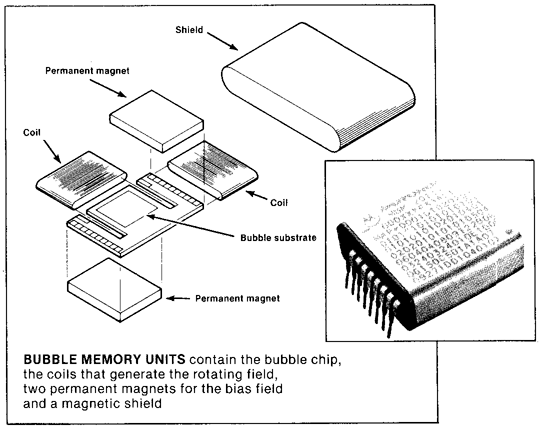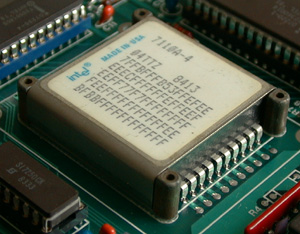The basics of bubble memory
In the early '80 semiconductor memory was relatively expensive and
the alternative, floppy disks or harddisks, too fragile and bulky for
some applications.
Therefore Intel (yes, they were in the memory business then) and others
looked for alternatives. Bubbles were one of them. It is easiest to see
bubble memories as floppies, but only the bits (bubbles) rotate. The
medium, or 'disk' is stationary.
The bubble technology was 'preliminary' in 1981 but became obsolete
within five years, when battery backup-ed CMOS-RAM became affordable.
The following texts and pictures are from the Intel "Memory Components
Handbook Supplement 1984" reprint section.
| Picture 1 |

| A magnetic bubble-memory stores data in the form of
cylindrically-shaped magnetic domains in a thin film of magnetic
material (The axis of the cylinder is perperdicular to surface of the
material. The presence of a domain (a bubble) is interpreted as a binary
1, and absence of a domain is oliver.nash@gmail.coma zero. Bubbles are created from electrical
signals by a bubble generator within the memory and reconverted to
electrical signals by an internal detector, usually a matched pair
of permalloy magnetoresistive sensor strips. Externally the memory is
TTL-compatible.
|
| Picture 2 |

|
An external rotating magnetic field propels bubbles through, the film,
metallic patterns, called chevrons, deposited on the film steer the
domains in the desired directions. In these respects, magnetic-bubble
memories are serial high-density storage devices like electromechanical
disk memories. In disks however, the stored bits are stationary on a
moving medium, whereas in the magnetic bubble memory the medium is
stationary and the bits move.
In the absence of power, the stored bits ( 'bubbles") are held intact
by the presence of permanent magnets, contained within the memory's
shielded package. Hence the non-volatility of data is assured. More
info on the Intel 7110 Functional Description
page.
|
| Gespac GESBUL-1 |

| This is a magnetic bubble memory as found on the
Gespac GESBUL-1, a GESBUS-64 system
euro-card.
It was used as data storage in the
Landis & Gyr Bomics work-time registration and access control system.
But that is ancient history.
See this Dvorak blog
for more info on what happend with bubble memory.
|
Local links:
Generic links:
Latest update: 2011-05-13
e-mail


